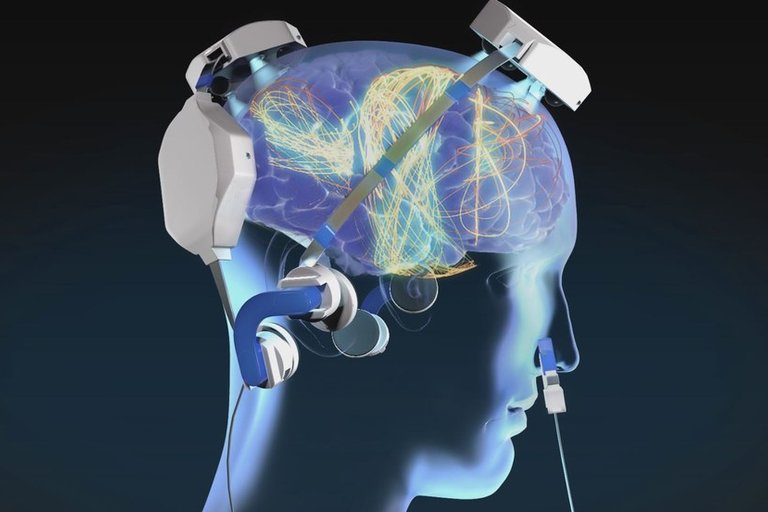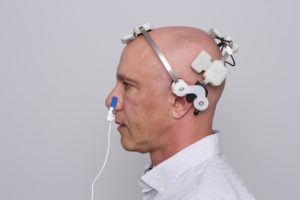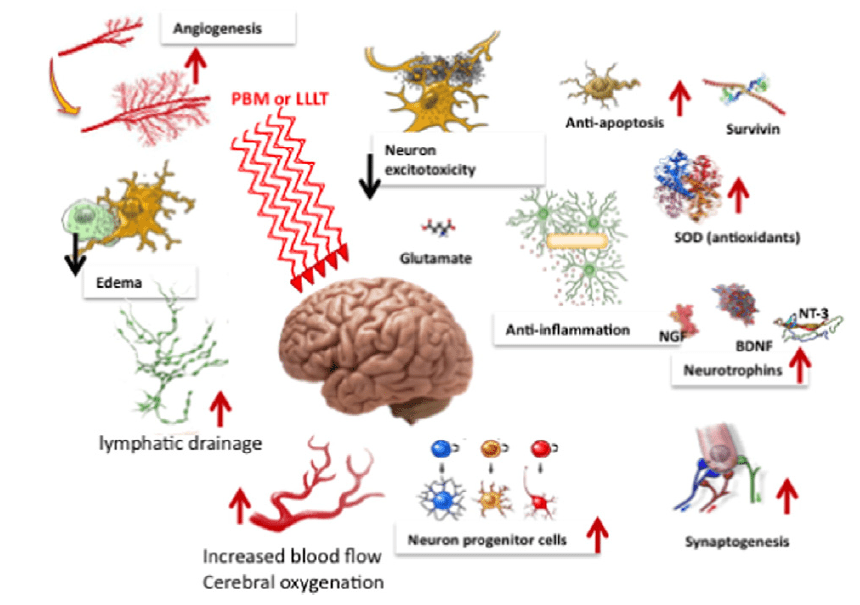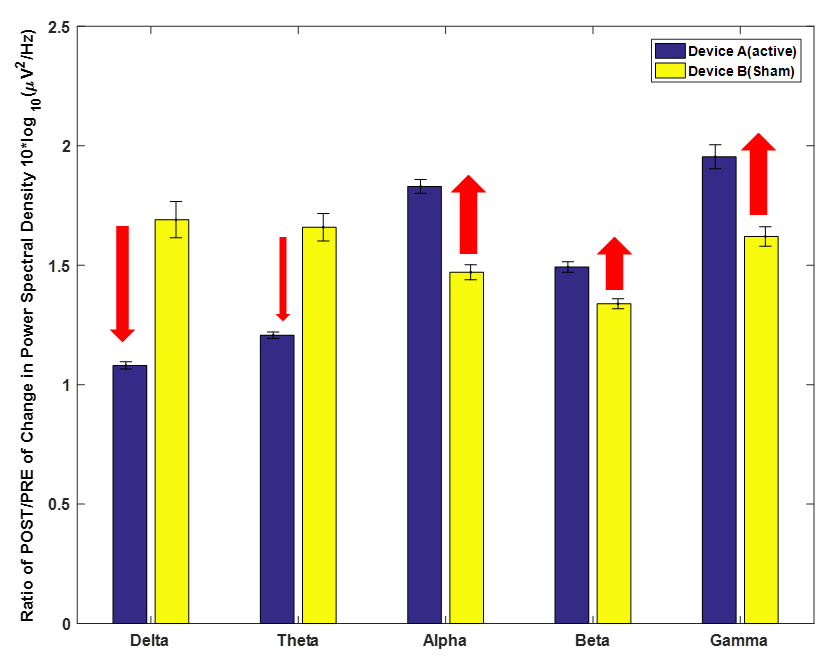Photobiomodulation: A new and promising way to enhance brain function
 ___
___
As is increasingly evident, there are multiple methods aimed at enhancing brain function.
Brain training and mindfulness practices are commonly used. Substance-based methods are popular too, including hallucinogens in the form of plant extracts, and drugs. Same as transcranial direct current stimulation (tDCS) and transcranial magnetic stimulation (TMS): All of these are promising but have been challenged — for example, the reproducibility of electrical-based stimulation results is increasingly questioned.

– Fig. 1: Vielight Neuro Alpha/Gamma in use
Within this context, photobiomodulation (PBM)–low level light therapy (LLLT)– is attracting much attention these days as a promising new way to enhance brain functioning. PBM involves delivering light to the cells (including neurons) that modulate tissue functions.
Fig. 1 (to the right) offers an illustration of a popular method of transcranial PBM, with Vielight Neuro Alpha/Gamma in use.
The Scientific Case for Photobiomodulation (PBM)
There are several factors supporting PBM for brain enhancement:
- Its fundamental mechanisms of action, based on photons modifying mitochondrial functions, are well-researched. Mitochondria health is increasingly recognized as fundamental in medicine.
- The photon is non-chemical, non-synthetic and non-mechanical. When activating the mitochondria in small doses, it modulates tissues without major side effects. Its life-harnessing activity appears to be a legacy from early life on earth that started with photosynthesis.
- The effects of transcranial PBM have been found to be systemic and generally agnostic in treating the different types of brain insults.
- Emerging evidence are presenting the effect of PBM on the electrophysiology potential of the brain as well as enhanced blood perfusion, filling some of the earlier gaps in the understanding and validation of brain PBM mechanisms.
Multiple scientific reviews, referenced below, have identified a number of neurological, psychiatric and neurodevelopment conditions that may in principle be addressed by transcranial PBM, from “chemo-brain” to depression and Parkinson’s Disease. With PBM delivered to the forehead in a controlled study, for example, subjects demonstrated improved memory and mood. When the right forehead was treated, it improved attention biased modification (ABM) in people with depression. Directing near infrared (NIR) light to the brain also improves reaction time. Functional near infrared spectroscopy (fNIRS) has measured increased cerebral oxygenation in the brain after a single transcranial PBM, which provides an explanation for the increased performance observed. Quantitative electroencephalography (qEEG) maps have also shown increased electrophysiology power.
In summary, PBM appears to have positive effect on both healthy and diseased brains.
The Potential in Selective Modulation
PBM can help modulate the brain in several ways:
- Blood perfusion– more so in the areas surrounding the source of light
- Activation of neuronal repair, restoration, growth and reduction of inflammation
- Increase in neurotransmitter activity
- Beneficial modification of microglia activity
- Entrainment of selective brain oscillations
- Potential for modulating focal synchrony/coherency

Fig. 2 above identifies tissue processes and benefits. For items 5 and 6 on the list above, Vielight and our collaborators are finding that by invoking a specific pulse rate at 810 nm wavelength, we can significantly influence brain oscillations. In a publication-pending study, gamma pulse rate at 40 Hz can consistently and significantly upregulate the higher oscillations of gamma, beta and alpha; and downregulate theta and delta. This is presented in Fig. 3 below. Specific locations can also be entrained to have more or reduced coherence

Fig. 3: Invoking 40 Hz with 810 nM wavelength upregulates gamma, beta and alpha brain waves, and downregulates theta and delta waves (the findings are pending publication)
As discussed, delivery of NIR can improve reaction time and performance. High frequency in the beta and gamma ranges have been associated with memory and mental performance, although temporary. High level meditators also present persistent gamma with high power. It is therefore reasonable to assume that entrainment with gamma frequency pulses can modulate the brain for high performing mental states in mindfulness.
Expectation for the Future
Growing evidence seems to support the case that PBM can enhance brain function, whether the brain is in perfectly healthy shape or has suffered insults. However, there is much to be explored. Specifically, because brains seem to respond to PBM in very specific ways, we should be able to personalize treatments and selectively alter mental states in the future.
In summary, these are the reasons why I view photobiomodulation as a new and very promising way to enhance brain function.
 –Dr. Lew Lim is the CEO & Founder of VieLight. As an engineer with a passion for helping people, Dr. Lim is the co-inventor of several wearable photobiomodulation (PBM)/ low level light therapy devices, and has been recognized for the development of the intranasal light therapy systems, particularly to address neurological issues. He will make a presentation at the 2017 SharpBrains Virtual Summit: Brain Health & Enhancement in the Digital Age this Thursday, December 7th, during Expo Day.
–Dr. Lew Lim is the CEO & Founder of VieLight. As an engineer with a passion for helping people, Dr. Lim is the co-inventor of several wearable photobiomodulation (PBM)/ low level light therapy devices, and has been recognized for the development of the intranasal light therapy systems, particularly to address neurological issues. He will make a presentation at the 2017 SharpBrains Virtual Summit: Brain Health & Enhancement in the Digital Age this Thursday, December 7th, during Expo Day.
_____
Come learn more about brain health innovation and neurotech HERE
(10%-off promo code for SharpBrains readers: sharp2017)
_____
References
- Barrett DW, Gonzalez-Lima F. Transcranial infrared laser stimulation produces beneficial cognitive and emotional effects in humans, Neuroscience 230 (2013) 13–23.
- Blanco NJ, Maddox WT, Gonzalez-Lima F, Improving executive function using transcranial infrared laser stimulation, J. Neuropsychol. (2015).
- Braboszcz C, Cahn BR, Levy J, et al. Increased Gamma Brainwave Amplitude Compared to Control in Three Different Meditation Traditions. PLoS One. 2017; 12(1): e0170647.
- de Freitas LF, Hamblin MR. Proposed Mechanisms of Photobiomodulation or Low-Level Light Therapy. IEEE J Sel Top Quantum Electron. 2016 May-Jun;22(3).
- Disner SG, Beevers CG, Gonzalez-Lima F, Transcranial laser stimulation as neuroenhancement for attention biasmodification in adults with elevated depression symptoms, Brain Stimul. (2016).
- Grover F Jr, Weston J, Weston M. Acute Effects of Near Infrared Light Therapy on Brain State in Healthy Subjects as Quantified by qEEG Measures. Photomed Laser Surg. 2017 Mar;35(3):136–141.
- Hamblin MR. Shining light on the head: Photobiomodulation for brain disorders. BBA Clin. 2016 Dec; 6: 113–124.
- Hennessy M, Hamblin MR. Photobiomodulation and the brain: a new paradigm. J Opt. 2017 Jan;19(1):013003.
- Héroux ME, Loo CK, Taylor JL, et al. Questionable science and reproducibility in electrical brain stimulation research. PLoS One. 2017 Apr 26;12(4):e0175635.
- Iaccarino HF, Singer AC, Martorell AJ, et al (2016). Gamma frequency entrainment attenuates amyloid load and modifies microglia. Nature 540(7632): 230–235.
- Keizer AW, Verschoor M, Verment VM, et al. The effect of gamma enhancing neurofeedback on the control of feature bindings and intelligence measures. Intl Jnl Psychphys, 201075(1 ), 25–32.
- O’Reilly EJ, Olaya-Castro A. Non-classicality of the molecular vibrations assisting exciton energy transfer at room temperature. Nature Comms. 2014. Online access.
- Parkin BL, Ekhtiari H, Walsh VF. Non-invasive Human Brain Stimulation in Cognitive Neuroscience: A Primer. Neuron. 2015; 87(5): 932–945.
- Picard M, Wallace DC, Burelle Y. The rise of mitochondria in medicine. Mitochondrion. 2016 Sep;30:105–16.
- Ravindra Arany PR. Photomedicine and Laser Surgery. August 2012, 30(9): 507–509.
- Tian F, Hase SN, Gonzalez-Lima F, et al. Transcranial laser stimulation improves human cerebral oxygenation. Lasers Surg Med. 2016 Apr;48(4):343–9.


